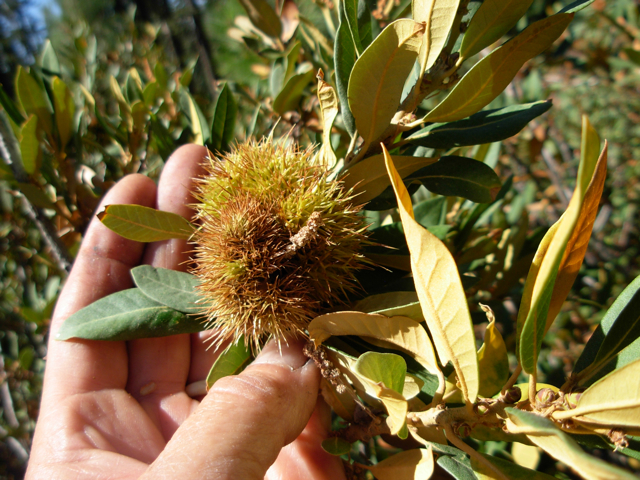

Ok, Ok, maybe you didn't forget it, but I run into very few people who have ever tried eating it or even know that it once was a popular food in California. And no wonder, it is absolutely delicious.
What to look for? Watch for the gold-backed leaves and the spiny burr. Nothing else is out there that looks like that burr. It is a green, spiny thing and it turns brown at maturity. Look for burrs that are just beginning to brown. If you wait until the burr is entirely brown it most likely has expelled its fruit. The fruit, i.e. the nut, matures in late summer to early fall.
The Latin names for our two California species are Chrysolepis chrysophylla (often tree-like and more coastal in habitat) and Chrysolepis sempervirens (bush/shrub-like and found in the Sierra Nevada Mountains). But the sound of chinquapin (ching-Ka-pin) is such a pleasure to pronounce that the Latin terms tend to be cast aside. California's chinquapins prefer slopes and ridges, not fertile valleys. Sunny, rocky and relatively infertile soil is to its liking. The Chrysolepis genus is endemic to the West Coast. The ones pictured in this article are the bush-form type. I found these chinquapins growing in the California central Sierra Nevada at around 5,000 ft. in a plant community inhabited by Ponderosa and Sugar Pines as well as manzanita.
Don't confuse this plant with the similarly named oak, Quercus chrysolepis i.e. Canyon Oak. Both West Coast chinquapin species and the canyon oak can have similarly shaped leaves. Canyon oak also sometimes has a bright yellow, fuzzy underside on the leaves much like the chinquapin. Ahh, those Latin language lovers know how to turn a phrase for a fuzzy golden underside. "Golden scale" is the translation for the Latin term chrysolepis. Just remember, the oak has acorns and the chinquapin has a four-valved spiny burr with 1 to 4 nuts inside.
The Eastern US has its own chinquapin (Castanea pumila) native to the East Coast from New Jersey south and west to Eastern Texas. Castanopsis is another plant genus with the common name of chinquapin (also chinkapin). At one time our West Coast chinquapin was classified as a member of this genus. All of these are rounded up under the more inclusive plant order Fagacea, the best known members of the order are the chestnuts.
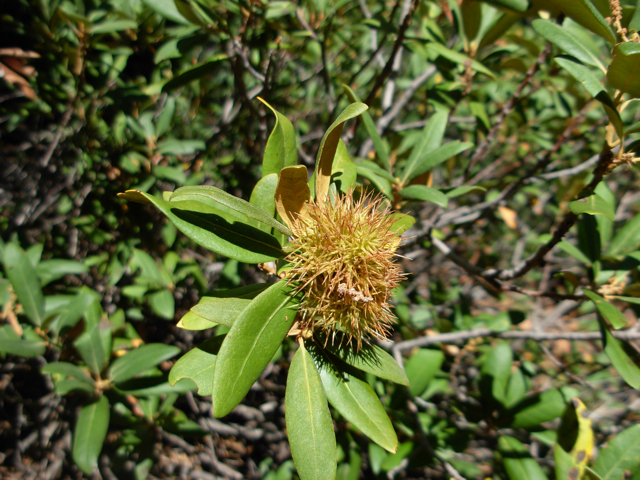
Now, a word of caution. That is one very spiny burr. Lacking a good pair of gloves, I ignored the many prickles. But after pulling several burr spines out of my hands the next day, I would recommend packing a set gloves when foraging in August or early September in case you happen upon this plant and want to gather.
Don't be fooled by what looks like a red berry. This is actually a gall formed by the chinquapin flower gall wasp. Some of the chinquapin bushes I gathered from looked like they were loaded with red fruit.
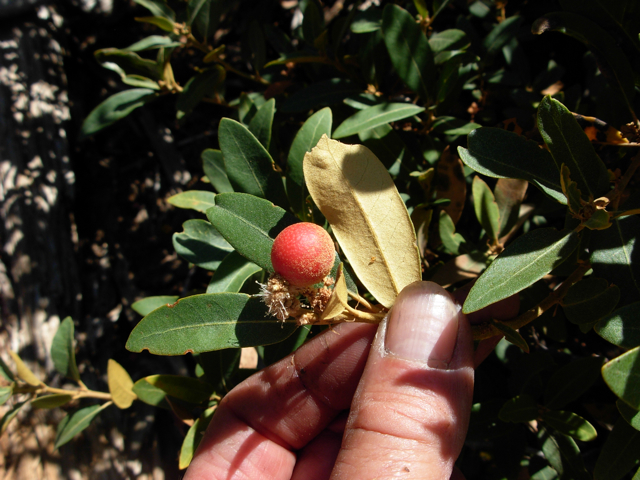
This nut is apparently a favorite of rodents, birds, and perhaps black bears too. Despite the fact many burrs had already expelled their nuts when I got there and a great litter of spiny burrs had already fallen, not one nut was to be found on the ground. Only the chewed remains of shells were seen, and not many of those. Not only do the rodents relish them, but you will also be in competition with the insect world for these morsels. Often I encountered nuts with insect larvae happily enjoying themselves inside. The good news is that they don't seem to spoil the nut in the process, and will leave you with some. I didn't sample the larvae themselves . . . . but who knows. I may be missing something.
When you gather, be aware that this fruit can take two years to mature. Finding a spiny burr is no guarantee of finding edible nuts. Look for burrs that actually contain mature nuts. Burrs often contain both aborted or immature nuts, so don't waste your time on those. Don't destroy the next crop of nuts by picking immature burrs. The tip of the mature nut may actually be visible nearly hidden in the spiny valves. The photo below shows such a nut within the valves . . . . but I did open it a bit to make it more visible. Don't expect every nut in a burr to be of the same stage or development. Often they are at different stages of maturity and size. That's OK. They are good when small or still somewhat green too. So if one nut is mature enough to be peeking its brown face out of its spiny home, the others in the burr may also be large enough and mature enough to be worth gathering. Another clue is that the burr itself becomes easier to pick when it matures. But when it falls off if touched it may be too late to find nuts inside.
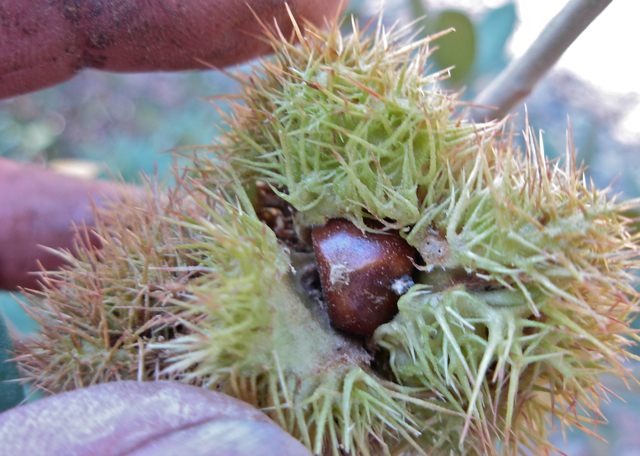
Here is a photo of a very pine-pitched and dirty hand with four of the larger mature nuts found. Nuts should be glossy when picked. Dull ones are usually "duds".
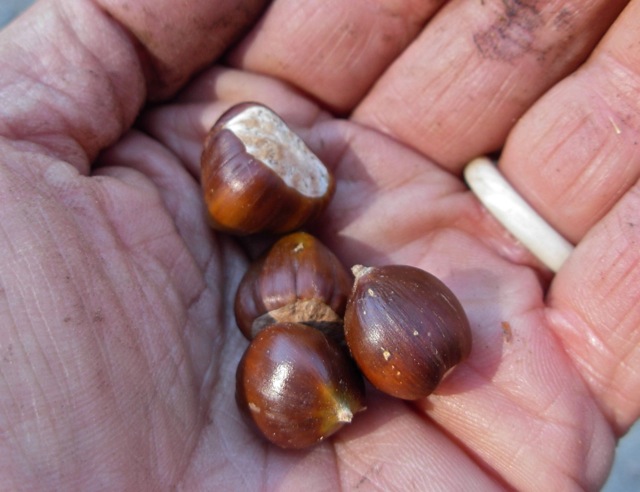
Now, here is the question. How do you get the nuts out?
If you are impatient, you can gently roll them about on the ground under your shoe (or a rock) until the prickles are fairly mashed. This usually expels ripe seeds and makes the prickles less intimidating when opening them barehanded. The burrs can also be spread out and dried, and the drying process tends to liberate the nuts.
You shouldn't expect an abundance of useable nuts every time you find chinquapin. It may just be a serendipitous snack when you happen upon it. Timing is critical and you may need to search for both burrs at the right stage of development and burrs without insect predation. From a survival situation perspective, local /seasonal abundance would be life saving. They are nutritious and require no leaching. But if it requires lots of calorie cost in foraging for a relatively low yield, it would make more sense to concentrate on other resources. Still, about an hour of low intensity gathering and processing yielded this taste-treat. They are so good, they are worth the effort. And finding a good-sized tree or a large stand of chinquapin at peak season on a good year could well produce a bonanza.
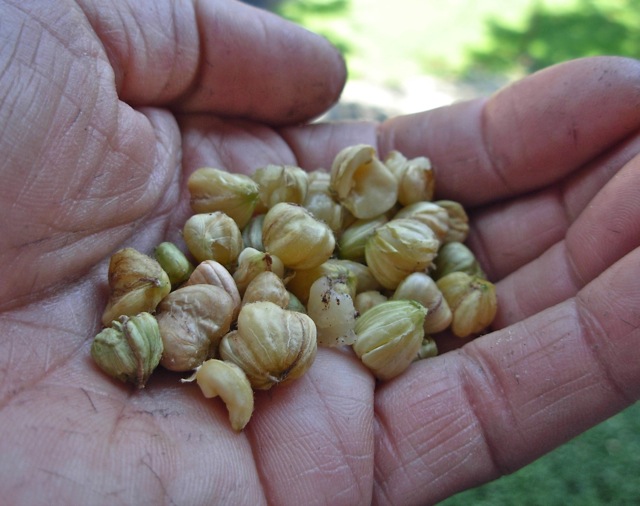
We hope the information on the PrimitiveWays website is both instructional and enjoyable. Understand that no warranty or guarantee is included. We expect adults to act responsibly and children to be supervised by a responsible adult. If you use the information on this site to create your own projects or if you try techniques described on PrimitiveWays, behave in accordance with applicable laws, and think about the sustainability of natural resources. Using tools or techniques described on PrimitiveWays can be dangerous with exposure to heavy, sharp or pointed objects, fire, stone tools and hazards present in outdoor settings. Without proper care and caution, or if done incorrectly, there is a risk of property damage, personal injury or even death. So, be advised: Anyone using any information provided on the PrimitiveWays website assumes responsibility for using proper care and caution to protect property, the life, health and safety of himself or herself and all others. He or she expressly assumes all risk of harm or damage to all persons or property proximately caused by the use of this information.
© PrimitiveWays 2016